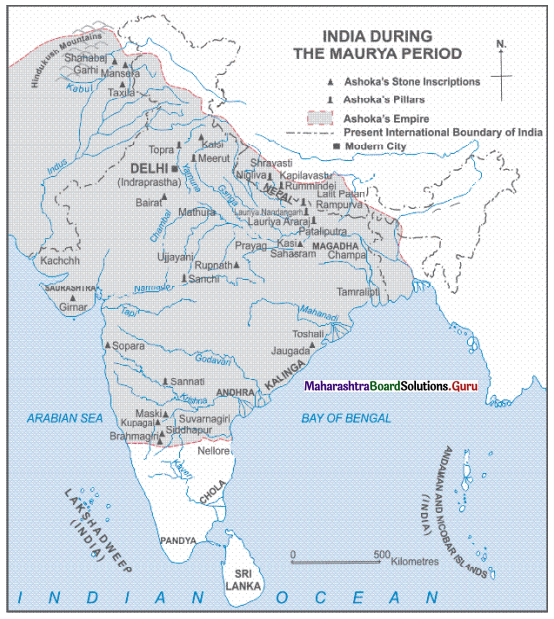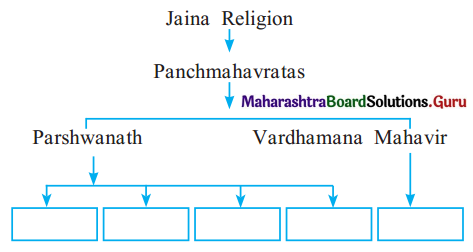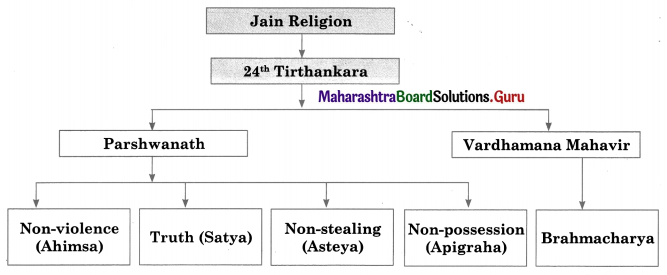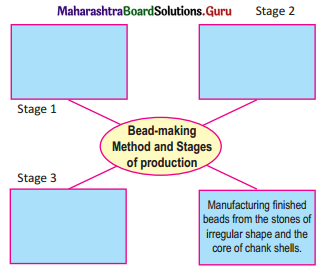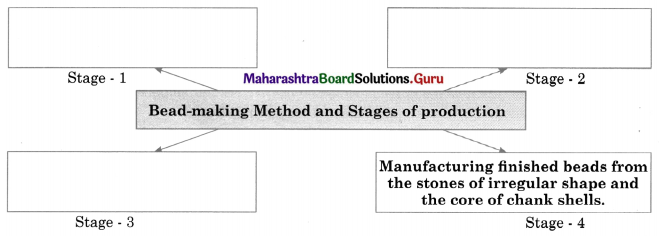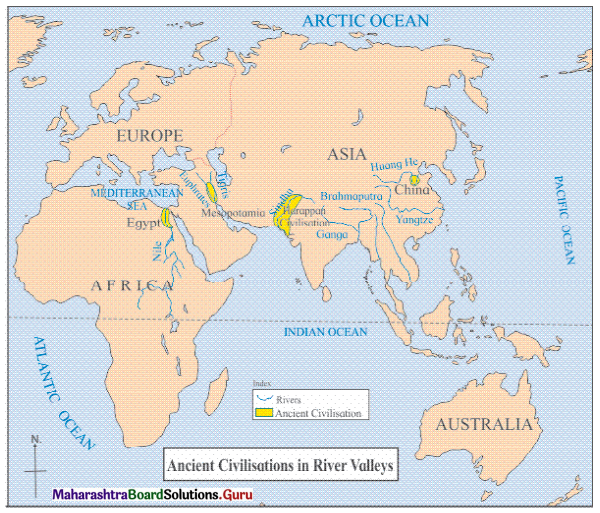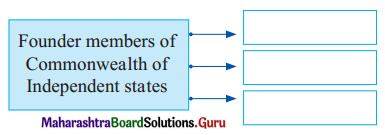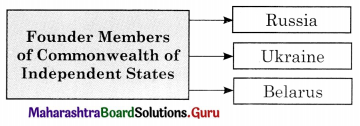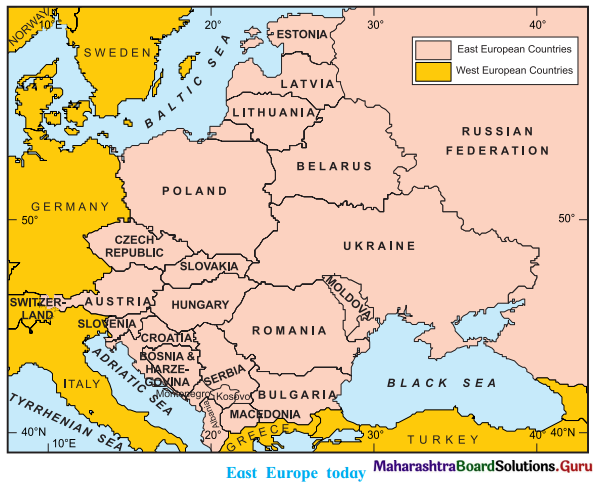Balbharti Maharashtra State Board Class 11 Sociology Solutions Chapter 1 Introduction to Sociology Textbook Exercise Questions and Answers.
Maharashtra State Board Class 11 Sociology Solutions Chapter 1 Introduction to Sociology
1. (A) Choose the correct alternative and complete the statements.
Question 1.
The term ‘Socius’ means ………………..
(science / companion / social)
Answer:
companion
Question 2.
The term ‘logos’ means ………………..
(associate / science / methodology)
Answer:
science
![]()
Question 3.
…………………. is often regarded as the ‘Father of Sociology’.
(Durkheim / Weber/ Comte)
Answer:
Comte
Question 4.
When sociologist make an effort to understand practical problems of daily life it is a/an …………….. science.
(pure / application / theoretical)
Answer:
application
1. (B) Correct the incorrect pair.
Question 1.
(a) Study of role of biology in human life – Bio-Sociology
(b) Study of social words of Art and Aesthetics – Sociology of Art
(c) Theoretical of knowledge in sociology in marketing segmental division of customers, Needs analysis etc. – Sociology of Market Research
(d) Study of visual dimensions of social life – Diaspora Studies
Answer:
(d) Study of visual dimensions of social life – Visual Sociology
1. (C) Identify the appropriate term from the given options.
(Diaspora Studies, The Positive Philosophy, Theoretical Science)
Question 1.
Comte coined the term sociology in this book.
Answer:
Positive Philosophy
Question 2.
Sociology is concerned with developing sociological theory.
Answer:
Theoretical Science
1. (D) Correct underlined words and complete the sentence.
Question 1.
When sociological research is done for its own sake it makes sociology a/an applied science.
Answer:
When sociological research is done for its own sake it makes sociology a pure as well as a social science.
Question 2.
Rape, hate, crimes and terrorism are examples of social institutions.
Answer:
Rape, hate, crimes and terrorism are examples of social problems/ pathology.
2. Write short notes.
Question 1.
Nature of sociology
Answer:
- Sociology is an empirical science : Sociology studies and analyses social facts on the basis of scientific method. Empiricism is it’s central feature as a science.
- Sociology is a theoretical and applied science : Verification and formulation of new theories is a constant process in sociology. Also, many branches of sociology are based on the application of sociological knowledge to the field. Hence, it is a ‘pure’ as well as an ‘applied’ social science.
- Sociology is a factual science : The aim of sociology of to find out the reality of society hence sociology studies the constructive part ans destructive elements in society.
- Sociology is a holistic science : Sociology does not limit itself to the study of any specific or particular aspect of society. It studies society as a whole.
![]()
Question 2.
New emerging areas in sociology
Answer:
The subject matter of sociology is very wide. Hence, new areas emerging in sociology are:
- Bio-sociology : Studies the role of biology in human social life.
- Sociology of art : Helps to understand the social world of art and aesthetics.
- Sociology of market research : It deals with the theoretical knowledge of sociology in marketing, segmental division of customers, needs analysis etc.
- Visual sociology : Based on visual dimensions of social life.
- Diaspora studies : Studies migration and its cultural, literacy, social, demographic, anthropological, political, economic impact and international of relations.
Question 3.
Enlightenment period
Answer:
- The Europe produced a ‘Scientific Revolution’ in the Renaissance period. There was increased emphasis on science in society as a whole. The technological advancement influenced every sector of life.
- The ideas and discoveries contributed by science led to emergence of sociology. This era is known as the enlightenment period.
- The Enlightenment period saw the beginning of the scientific revolution. Science was considered in the social context and looked at as a tool for satisfying the needs of humanity.
- New scientific discoveries helped in the eradication of blind beliefs. This period has made a significant contribution to shaping a scientific attitude in Sociology.
3. Differentiate between.
Question 1.
Natural Science and Social Science.
Answer:
| Natural Science | Social Science |
| (i) A study of natural Sciences includes physical, chemical and biological factors of nature. | (i) Social sciences like economics, political science, sociology studies different aspects of society with major concerns of human beings. |
| (ii) It studies objectively and in very scientific manner because experimentation in the laboratory is possible. | (ii) It also studies objectively and adopts certain scientific methods but to conduct experiment in the laboratory is not possible at all times. |
| (iii) Results and findings are more accurate and exact. | (iii) Difficult to maintain accuracy and exact predictions about human behaviour. |
| (iv) Example : Biology, Chemistry, Physics, Botany etc. | (iv) Example : Sociology, Geography, History etc. |
Question 2.
Theoretical Science and Applied Science.
Answer:
| Theoretical Science | Applied Science |
| (i) Theoretical research is explanatory and leads to the advancement of knowledge. | (i) Applied science is for development purposes and solves practical problems of society. |
| (ii) Theoretical framework is the structure that can hold the theory. | (ii) Applied science means practical application of sociological theory. |
| (iii) The purpose of theoretical science is to increase understanding. | (iii) The purpose of applied science is to bring about social change. |
| (iv) Example – A study of the social structure of a slum. | (iv) Example – A study, to prevent delinquency in a slum. |
![]()
4. Explain the following concept with suitable examples.
Question 1.
Diaspora
Answer:
- Diaspora is he movement of the people from their original place to other geographical area.
- Though people migrate they maintain their originality in the migrated area.
- The people though they have migrated from their original place, follow their rituals, customs and maintain their original existence in areas where they have been migrated.
Example: Migration of rural people to urban area.
Question 2.
Bio-Sociology
Answer:
- Bio-Sociology is a subject that has emerged relatively recently in Sociology.
- Researchers in the area use a variety of sociological methodologies to study the role of biology in human social life.
- Biologically male and female are different. Both have different strength and capacity because of their body structure. But in society culture plays different role in nurturing them.
- These discrimination and differences affected the society in a great way. Bio-Sociology helps to understand this concept.
Example : Gender differences and discrimination.
5. (A) Complete the concept maps.
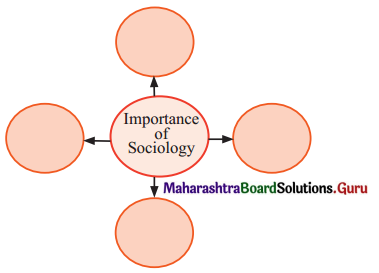
Answer:

5. (B) State whether the following statements are true or false with reasons.
Question 1.
The French revolution led to changes in society.
Answer:
This statement is True.
- French Revolution was one of the best examples of struggle for freedom and equality.
- Through this revolution feudal system had been overthrown. The new system came into existence which was based on the principles of liberty, fraternity and equality.
- French revolution brought tremendous changes in the life of the people not only in France but all over Europe. Hence, French revolution led to changes in society.
Question 2.
The development in natural sciences has had an impact on sociology as a discipline.
Answer:
This statement is True.
- Natural sciences are differentiated from other modes of knowledge, by method, not by subject matter.
- The revolutionary concept that social phenomena are natural phenomena and therefore can be studied by natural – science methodology is being rapidly accepted.
- Sociology uses scientific methods and research to solve the many problems of society like poverty unemployment etc. Hence, the development in natural science has had an impact on sociology as a discipline.
![]()
6. Give your personal response.
Question 1.
Is India in the ‘scientific’ stage of growth? Explain why you hold the view that you do.
Answer:
Yes, India is in the ‘scientific’ stage of growth.
During ancient period India faced many social problems like blind faith, illiteracy, child-infanticide etc. Many cultural, political differences etc., were followed. By adopting scientific method, sociologist have been trying to minimize the problems. They have suggested some measures to the government to find out certain solutions to solve the problems.
The technological and scientific advancement influenced every sector of life. India’s scientific stage of growth includes technical development, which have resulted in technological inventions for scientific growth.
Question 2.
Explain in brief the link between cinema and society.
Answer:
Cinema is one of the means of mass media. Cinema and society are inter related and inter connected with each other. Society influences the cinema and vice versa. But cinema has both positive and negative influences on the society. As far as India is concerned one can find diversity in each and every aspect of society. In such situations cinema plays important role in integrating the society. It also helps to inculcate certain values like honesty, hard work, sympathy, charity, brotherhood etc.
Society influences the cinema and its subject matter. Film makers give special attention on the interest and demand of the people of the society.
7. Answer the following in detail (About 150-200 words).
Question 1.
Discuss with suitable examples, the scope of sociology in today’s world.
Answer:
The following points explains the scope of sociology in today’s world.
1. Bio-Sociology – Example : Gender differences and discrimination. Researchers in the area* use a variety of sociological methodologies to study the role of biology in human social life.
2. Sociology of Art – Example : Warli paintings depicts their lifestyle or paintings related with Mohenjo Daro and Harappan Civilization. This area helps to understand the social world of art and aesthetics. This field seeks to understand the social context of the production and consumption of art.
3. Sociology of Market Research – Example : Advertising of bathing soap by convincing the people that they have used river Ganga’s water in that. This is an applied field that connects marketing and sociological strategies to understand the market in a meaningful way.
4. Visual Sociology – Example: A researcher takes help of newspaper, film, movie, photographs for their study or for the study of a particular society. Visual sociology is concerned with visual dimension of social life. With the help of film, movie, pictures one can visualize or imagine a particular problem, on the basis of which valid and relevant data can be collected.
5. Diaspora Studies – Example : Migration of rural people to urban area. Diaspora is one of the movements of the people from their original place to other geographical area. Though people migrate they maintain their originality in the migrated area. The people though they have migrated from their original place, follow their rituals, customs and maintain their original existence in areas where they have been migrated.
![]()
11th Sociology Digest Chapter 1 Introduction to Sociology Intext Questions and Answers
ACTIVITY (Textbook Page No. 6)
Question 1.
You have read about commercial, scientific, industrial and French revolutions which were responsible for the emergence of Sociology as a discipline. Identify the effects of industrial development on Indian society.
Answer:
The effects of industrial development on Indian society are:
- The use of new tools, machinery and techniques have increased the production speed of goods.
- Development of trade, new institutions like, banks, credit /debit card facilities emerged.
- Industrialization lead to Urbanization leading to migration of people from rural to the urban areas.
- Rise in the factory system of production which provided many new job opportunities in small and large scale industries.
- Emergences of new organisation and industrial policy.
- Increase in national income.
- Improved living standards of the people.
- Stimulation of progress in other sectors of the economy.
- Promotes specialization of labour.
- Provides large scope for technological progress.
![]()
Question 2.
Interview two people from your local area, who have migrated from another place. Find out the reasons for shifting and ask about their experiences and problems. (Textbook Page No. 8)
Answer:
Following is a case of inter-state migration in India.
Interview name : Mr. XYZ
Migrated from : Bihar
Migrated to : Mumbai.
Reasons : Advanced economic and social life. Advanced / better quality of education. Faster access to facilities and services like healthcare, education, etc. Higher job opportunities and better standard of living.
Experience : As time passes, a house on rent. Good education to children. Happy urban life.
Problems : Language barriers
Discrimination and inequality
Less paid
Difficulties in job hunting
Exploitation housing problems
Question 3.
Visit any nearby NGO and collect information about their work. Prepare a PPT and present it in your class. (Textbook Page No. 9)
Answer:
Akshara : Empowering Women and Girls.
Akshara is a society helping women live a violent free dignified life without discrimination. It focuses on empowering women and girls through education, productive works and resistance to violence in their lives, so they can be strong and independent contributing members to society.
Akshara has a three-dimensional vision for change:
- Changing hearts and minds of young women and men.
- Transforming public attitudes
- Reforming systems that deny gender justice
Work – (a) Akshara provides scholarships for education, training in life and technical skills and job placements for socially, economically disadvantaged young women.
(b) Akshara trains young men to become support gender equality and take up personal and social action.
(c) Akshara caters gender oriented educational stuff, online a training material videos and documentaries.
(d) Akshara lobbies with the state.
Vision – To establish a gender equality and violence free society
Goods – (a) Enhance societal consciousness on gender inequality.
(b) Employment of women and youth.
(c) Prevent violence towards women.
![]()
Question 4.
Discuss the statement listed
(i) Sociology is practical and related to life
(ii) Careers in Sociology. (Textbook Page No. 11)
Answer:
(i) Sociology is practical and related to life : Practical sociology refers to a form of sociological practice that is concerned with using sociological theories and research to understand on going activities. It is the task of sociology to study the social problems through the methods of scientific research and to find out solutions to them.
Sociology studies everyday social life, human interaction, institutions, behaviour and its origins. Sociology helps us to understand our and other people’s culture and environment.
(ii) Careers in Sociology.
- Human Resources
- Journalism
- Social Work / Public services
- Academics
- Consumers Relations
- Lawyer
- Guidance Counsellor (Guidance counsellor use knowledge of the Sociology of learning to help students navigate the academic world.)
